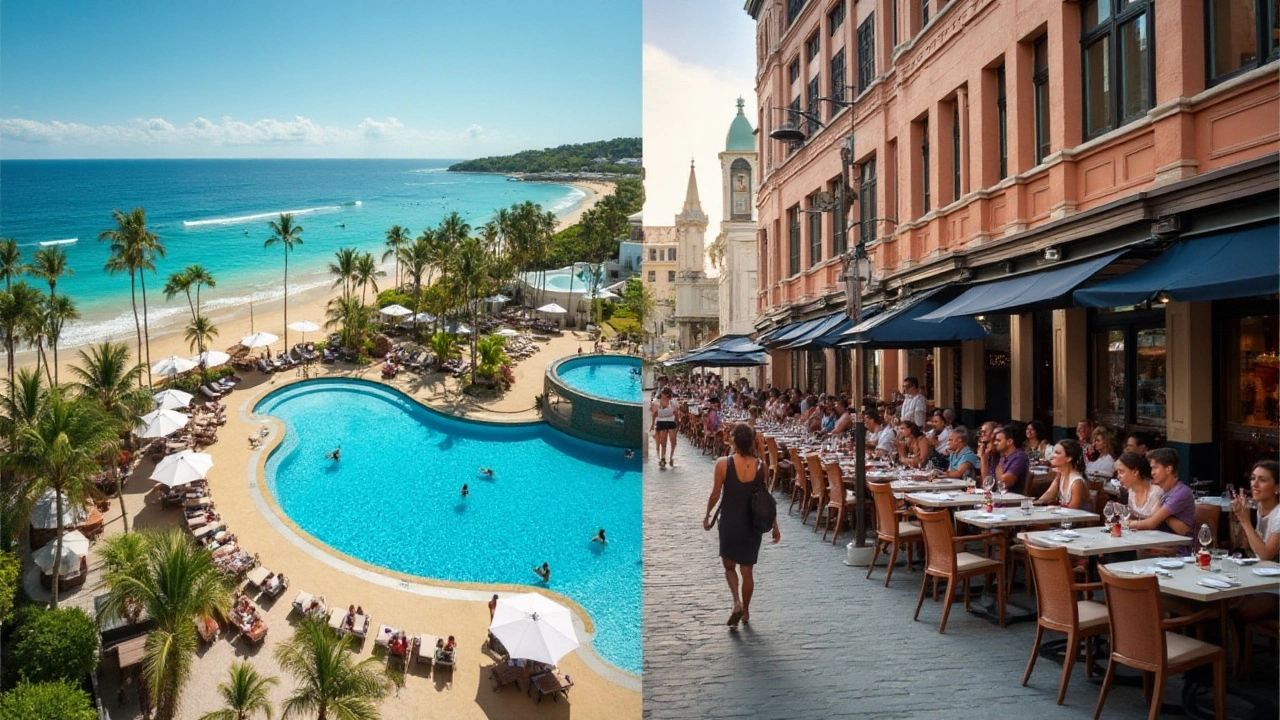All-inclusive resorts have long been an attractive option for travelers looking for a hassle-free vacation experience. With a single payment, guests can enjoy their accommodation, meals, drinks, and often entertainment without worrying about additional costs. Yet, in the vast landscape of the American tourism industry, such resorts remain virtually uncommon.
This isn't because the concept lacks appeal. Quite the opposite, North Americans are among the most frequent patrons of all-inclusive paradises abroad. So, why does the US remain conservative in embracing this model at home? By understanding historical, economic, and consumer dimensions, we can start to unravel this complex travel conundrum.
- History of All-Inclusive Resorts
- Economic Implications in US Markets
- Consumer Preferences and Trends
- Legal and Operational Challenges
History of All-Inclusive Resorts
The story of all-inclusive resorts begins in the 1950s when Gérard Blitz, a Belgian water polo champion and entrepreneur, envisioned a vacation model that allowed people to escape and relax without worrying about costs. Blitz founded the now-famous Club Med, which introduced the concept of an all-inclusive holiday experience. The first resort opened in Alcudia, Spain, creating a space where guests could forget their wallets and immerse themselves in leisure. This revolutionary idea quickly gained popularity across Europe as vacationers sought a convenient, care-free means to enjoy sun, sand, and entertainment.
Throughout the 1960s and 1970s, all-inclusive resorts spread from the Mediterranean to the Caribbean, a region that became synonymous with this novel approach to travel. Jamaica, the Dominican Republic, and Mexico's Cancún emerged as hotbeds for this burgeoning industry. These destinations offered breathtaking natural beauty combined with the exotic allure, drawing tourists from the colder North American climates. This growth wasn't incidental; it was supported by these nations' governments eager to stimulate their economies through tourism. At this time, all-inclusive packages typically included not just accommodation and meals, but also activities like scuba diving and local excursions.
Leisure trends continued evolving through the late 20th century, and so did the offerings of these resorts. By the 1990s, the all-inclusive model matured into what travelers recognize today — sprawling properties featuring multiple restaurants, bars, and themed entertainment options. Major hotel chains like Sandals and RIU followed suit, fortifying the Caribbean's position as a leader in the industry. These evolving offerings were a testament to the growing demand for vacations where every detail is considered, and every cost is prepaid, still a novel concept for many American travelers whose vacations often included a la carte costs, adding unforeseen stress and spend.
Notably, this model remained elusive in the U.S. domestic market. Part of this reticence can be traced back to differing cultural and economic factors—American consumers, accustomed to choice and customization, found it hard to adapt to structures that seemed rigid and lacking in spontaneity unless abroad. The U.S. hospitality sector, deeply entrenched in a tradition of flexibility and diversity, encountered challenges replicating this model at home, where everything from zoning laws to consumer expectations created barriers. Thus, the trajectory of all-inclusive resorts internationally presents a curious case study of adaptability and resistance, shaping a narrative as much about cultural preferences as it is about business models.
The all-inclusive model, according to travel expert Samantha Brown, "is both an escape and an experience, packaged in a way that lets reality fade to the background, a luxury many crave but few realize it can't always be found on home soil."

Economic Implications in US Markets
In exploring why all-inclusive resorts are rare in the United States, economic factors play a significant role. The US hospitality industry operates uniquely compared to international markets where these resorts thrive. One dominant reason is the high operational costs associated with staffing, property management, and complying with regulations in the United States, which can be a deterrent for implementing the all-inclusive model. The American market heavily relies on individual spending within tourism hubs, and encouraging tourists to explore local dining, shopping, and entertainment options generates substantial revenue for surrounding businesses. This inherently discourages a model where tourists stay on one property for their entire vacation.
A critical consideration is the price sensitivity of the North American consumer. US-based tourists often prefer flexibility in their travel plans, which is contrary to the all-inclusive model. Americans relish choices, whether it is in dining or activities, and tying them to a single venue is a strategic challenge for all-inclusive businesses. "People want to explore the country they travel to," said Erika Richter, senior director of communications at the American Society of Travel Advisors.
"They want a taste of every flavor, not just the one on the property". This preference influences economic decisions when considering the potential profitability of an all-inclusive resort.
Moreover, the scale of existing resorts in popular US destinations like Florida, California, and Nevada often means these properties thrive on individual booking services and on-site purchases. Logistical complications, such as varying state tax laws and the complexity involved in offering a consolidated pricing model, present additional barriers. Many hotels prefer to maintain control over their pricing structures, offering customized vacations that invite guests to spend liberally on extras, like premium dining and experiences, fueling a much-needed economic cycle in tourist-heavy regions.
The disparity also lies in how US-based vacations are marketed. Often, American travelers are drawn to package deals which include a variety of experiences from ticketed events to adventure tours, effectively bypassing the need for all-inclusive resorts altogether. An interesting fact comes from an analysis by the US Travel Association, which found that domestic leisure travel spending in 2022 exceeded $800 billion. This reflects a robust market benefiting from additive experiences rather than enclosed all-inclusivity. By catering to varied interests and spontaneity, the hospitality sector ensures steady profitability without all-inclusive resorts.
The concept of all-inclusive resorts, while financially enticing, in essence, does not align readily with the broader economic frameworks and consumer habits prevalent in the United States. From pervasive high operational costs to a marketplace driven by diversity and flexibility, this model seemingly finds more challenges than opportunities within American borders. Still, as consumer preferences evolve and the industry adapts, potential exists for these resorts to carve a niche in the ever-changing landscape of US tourism.

Consumer Preferences and Trends
The landscape of travel has been evolving at an unprecedented pace, with consumer preferences significantly shaping the hospitality industry. In the United States, the travel culture leans heavily toward personalization and the freedom to create bespoke vacation experiences. Unlike the one-size-fits-all appeal of all-inclusive resorts, many American travelers favor flexibility. They enjoy the liberty to explore local eateries, venture on spontaneous excursions, and personalize their itineraries as they see fit. Such preferences are rooted deeply in American culture, which prioritizes individualism and custom-crafted experiences.
The love for personalization isn't just a trend but a growing expectation. With the advent of platforms like Airbnb and Vrbo, accommodations have adapted to this demand. These platforms allow travelers to choose unique lodgings that cater to their specific tastes and interests. As a result, traditional all-inclusive packages struggle to maintain relevance in a market that thrives on diversity and choice. This shift is evident in booking statistics. While international travel to all-inclusive destinations remains high, domestic bookings for such models are comparatively lower, reflecting these ingrained preferences.
Modern Consumer Demographics
Another crucial factor shaping the US market's reluctance towards the all-inclusive model is the demographic diversity of its travelers. Millennials and Gen Z travelers, who currently make up a large segment of the market, demand unique, Instagram-worthy experiences. They often seek adventure and cultural immersion, which conventional all-inclusive offerings rarely provide. Their quest for authenticity often leads them to destinations where they can interact with locals and engage in activities that steal them away from the confines of a resort. This ties into their broader travel narrative, which values storytelling and meaningful life experiences.
Interestingly, a study by the Adventure Travel Trade Association showed that millennials prioritized activities like hiking, exploring nature, and visiting historical sites over lounging at a resort. This demographic is also more eco-conscious, favoring sustainable travel practices that all-inclusive resorts have been slower to adopt. They prefer vacations that not only entertain but educate and immerse them in the local culture. Thus, it becomes clear why American-based all-inclusive resorts do not gain as much traction when these younger travelers are more inclined to seek alternatives that offer deeper connections to the world around them.
"The sheer range of activities and freedom offered by choosing independent travel options is hard to replicate in an all-inclusive environment." – National Geographic Traveler
Furthermore, the baby boomer generation, which significantly contributes to the travel economy, also shows varied interests that all-inclusive resorts might not entirely cater to. According to data from AARP, many boomers seek multi-generational travel experiences, where activities can engage both the young and old. Resorts operating on an all-inclusive model often target a particular age group, which may not fully satisfy the diverse needs of family-oriented trips. Consequently, the preference for vacation rentals, customized travel packages, and diverse lodging options becomes apparent across age groups.
The Rise of Local Experiences
In addition, the pandemic catalyzed a shift in travel habits, with many Americans embracing the idea of local tourism. With international travel restricted, domestic tourism soared, encouraging travelers to explore the vast cultural heritage within their nation. This rise of local tourism has reinforced a preference for more varied and exploratory travel options, making the structured and often secluded setting of all-inclusive resorts less appealing to those yearning to delve into regional treasures.
Understanding these trends and preferences sheds light on why the US hospitality industry has largely eschewed the all-inclusive model. It's a fascinating glimpse into the psyche of the American traveler, revealing a rich tapestry of desires that veer towards diversity and exploration. In the face of evolving travel tastes, the industry continues to adapt, and while all-inclusive resorts may not dominate the domestic landscape, they are a cherished choice for those venturing abroad.

Legal and Operational Challenges
Operating an all-inclusive resort within the United States comes with its own set of challenges that are not merely economic but also deeply entrenched in the country's legal and operational frameworks. The hospitality sector, particularly in terms of resorts, is subject to a labyrinth of regulations that vary not only from state to state but sometimes from one municipality to another. This patchwork of rules can prove daunting for operators seeking to establish a consistent all-inclusive model across different locations. Zoning laws, for example, often dictate what types of businesses can operate in certain areas, and these laws may limit how resorts can bundle services such as entertainment and dining into a single package.
Tax regulations further complicate matters as they can affect how an all-inclusive resort must account for its various included offerings. Managing a business model that encapsulates lodging, food, and alcohol under one charge involves navigating a complex tax landscape. Each state may have different rates and requirements in terms of sales taxes, hospitality taxes, and even taxes on specific commodities such as alcohol. Such financial intricacies require detailed planning and expertise, which can be a significant barrier to establishing or expanding all-inclusive resorts on American soil. Additionally, the operational scope of all-inclusive resorts demands a seamless integration of multiple services, from dining to housecleaning to leisure activities, all requiring a high degree of coordination and staffing. This requires not just a conceptual alignment but operational excellence across departments and services offered.
Labor laws also play a significant role, as the hospitality industry heavily relies on both part-time and full-time staff. These laws can influence everything from wage structures, tipping policies, which are a cultural staple in American service industries, to work hours and benefits. Managing staff effectively while adhering to labor regulations requires a strong understanding of both federal and state laws. Offering a single, comprehensive price could also lead to complications with expectation management and contractual obligations, as guests become accustomed to a certain level of service encountered at international all-inclusive locations which may not be economically viable in the U.S.
To quote industry expert and author Rick Steves, "Operating an all-inclusive resort is a dance of economics and hospitality that requires more than just a great view and a drink in hand; it requires understanding people and policies."
A competitive market further pressures US-based resorts to maintain their edges, and strategically, some have found niche success in luxury or theme-driven experiences rather than the broad-spectrum approach typical of all-inclusive offerings. This allows the resorts to charge premium prices without lump-sum inclusivity, yet deliver high perceived value which might be more attuned to domestic travelers. In addition to addressing the legal realities, prospective all-inclusive operators must also overcome operational logistics unique to the demographics and preferences of American travelers.
Lastly, with the rapid movement towards online booking platforms and demand for immediate customer service responses, technology becomes both a challenge and an enabler for these resort models. Ensuring that availability, booking, check-in, and service requests flow seamlessly, while keeping up with the latest tech trends, is critical. Implementing technology that supports operations and enhances the guest experience is non-negotiable in staying competitive and managing the all-inclusive resort dream. This underlines the importance of flexibility and strategic planning in an ever-evolving market.
